50 Cheap & Easy Outdoor Hanging Planter Ideas To Beautify Your Yard
Are you tired of looking at your outdoor space and feeling uninspired? You’re not alone. Many people struggle to make the most of their limited outdoor areas or desire to enhance the beauty of their homes from the outside in. But what if I told you there’s a simple, yet effective way to transform your outdoor spaces without breaking the bank or sacrificing style?
Understanding Hanging Planters
With the concept of hanging planters being a timeless favorite, it’s no surprise that they continue to thrive as a way to bring beauty and greenery into our spaces. By suspending them from ceilings, walls or other supports, these planters allow plants to grow downwards, making them an ideal solution for areas where floor space is at a premium.
Definition and Brief History
A hanging planter is a clever way to bring plants into your life without taking up valuable floor space. Typically, these planters are suspended from above using cords, chains, or ropes, adding a touch of elegance and whimsy to any room.
Interestingly, the concept of hanging gardens dates back thousands of years to ancient civilizations who sought to merge nature with their living spaces, regardless of the challenges they faced.
The Hanging Gardens of Babylon, one of the Seven Wonders of the Ancient World, is a famous example of this architectural innovation.
Types of Hanging Planters
There’s no one-size-fits-all solution when it comes to hanging planters. Instead, you’ll find a variety of options that cater to different tastes, spaces, and plants. Each type has its own distinct character, making it easy to find the perfect match for your outdoor areas. Pots are the most versatile option, suitable for almost any plant. Whether you’re dealing with lush foliage or delicate blooms, pots have got you covered.
Their versatility is unmatched, allowing them to fit seamlessly into any setting. Macramé holders bring a touch of bohemian flair, perfect for showcasing small, decorative plants. The rope and cotton used in their construction add an organic feel that’s hard to resist. They’re ideal for adding a pop of greenery to a small space or highlighting a favorite plant. Tiered hangers take the concept of vertical gardening to new heights – literally.
By creating multiple levels, you can fit more plants into a smaller area, maximizing your outdoor space. The use of metal or wood adds a touch of industrial chic, making it perfect for modern or minimalist spaces. For those looking to get creative and make a statement, recycled materials offer an eco-friendly option that’s both unique and sustainable. By repurposing old containers and DIY items, you can turn trash into treasure – and do your part for the environment in the process.
Benefits of Using Hanging Planters in Outdoor Spaces
By incorporating hanging planters into your outdoor spaces, you can reap numerous benefits. One significant advantage is the ability to maximize even the smallest areas, such as balconies, patios, or bare walls, by adding a touch of greenery without taking up valuable floor space. Additionally, these planters introduce vertical interest, drawing the eye upward and creating a more dynamic visual experience.
For city dwellers, hanging planters can provide a welcome respite from urban surroundings, improving air quality and offering a personal oasis in even the tiniest of spaces. Furthermore, their flexibility allows you to effortlessly reposition them as needed, accommodating changing sunlight requirements or design preferences.
With their simplicity and effectiveness, hanging planters offer an ideal solution for enhancing both the aesthetic appeal and functional value of your outdoor areas, whether you’re working with a sprawling garden or a compact balcony.
Choosing the Right Plants
Choosing the ideal plants for your hanging planters requires a thoughtful approach that goes beyond simply selecting visually appealing blooms. To guarantee the health and vibrancy of your plants, as well as the aesthetic appeal of your outdoor space, you need to consider several key factors.
These include the specific lighting conditions of the area where the planter will reside, the amount of maintenance you’re willing to commit to each month, and the overall style or theme you hope to achieve with your plant selection.
Considerations for Selecting Plants
To select the perfect plants for your hanging planters, consider the fundamental factors that influence their growth. Start by thinking about the amount of sunlight your outdoor space receives – does it get full sun, partial shade, or is it mostly shaded? This will help you choose plants that thrive in those conditions. Next, consider the water needs of your potential plants. Some require frequent watering, while others can survive with less moisture.
Your local climate also plays a crucial role; if you live in an area prone to extreme weather, you’ll want to select hardy plants that can withstand those conditions. Finally, think about the growth habit of each plant – will it get too big for your planter or does it have a compact growth pattern? By taking these factors into account, you’ll be able to choose plants that are well-suited to your environment and your ability to care for them.
Tips for Arranging Plants for Visual Impact and Health
When it comes to arranging plants in hanging planters, careful consideration can have a significant impact on their health and the overall aesthetic of your outdoor space. To achieve a visually stunning display that also fosters healthy growth, follow these key tips:
Elevate the Visuals: Combine plants with varying heights, colors, and textures to create a captivating visual arrangement.
Growth Guidance: Position taller plants at the center, surrounded by trailing varieties to achieve a lush, full appearance.
Breathe Easy: Ensure plants have sufficient space to grow without overcrowding, which can hinder air circulation and increase disease risk.
Pot Perfectly: Select a planter that provides ample room for your plants’ growth and features good drainage to prevent waterlogging and root rot.
By thoughtfully applying these guidelines, you’ll be able to craft hanging planters that not only look incredible but also thrive and remain healthy. Whether you’re an experienced gardener or just starting out, these tips will help you maximize the potential of your outdoor hanging planters.
DIY Hanging Planter Ideas
Elevate your outdoor spaces with a touch of personality by creating your own hanging planters. This engaging DIY project allows for creativity and self-expression without requiring extensive crafting expertise. The result is a unique and visually appealing way to showcase plants, adding charm and character to your surroundings.
Step-by-Step Guide for Creating a Basic Macramé Hanging Planter
To infuse your outdoor space with a charming, vintage flair, try crafting a macramé hanging planter. This project is surprisingly easy and only requires a few basic materials: cotton cord, a metal or wooden ring, scissors, and a pot that can snugly accommodate your plant. Begin by cutting eight equal lengths of cord, each approximately 4 meters long. Next, fold the cords in half and loop them through the ring to create the foundation for your planter.
Once you have the base established, start knotting the cords together in pairs, working your way down the length of the planter. Alternate between adjacent sections, securing each pair with a knot spaced about 3 inches apart. Continue this pattern until your netting can securely support the weight of your pot and plant. Finally, gather all the loose ends at the bottom of the planter and tie a sturdy knot to keep everything in place.
With any excess cord trimmed away, you’re ready to hang your new planter and enjoy its unique, bohemian charm.
Ideas for Repurposing Household Items into Unique Planters
Before discarding household items, take a moment to think creatively. Many can be repurposed into one-of-a-kind hanging planters for your home or garden. To get started, consider the following ideas: Old colanders: Attach chains and hang them upside down to create unique planters for plants that require good drainage. Coconut shells: Cut in half and drill holes for stringing up small plants with a natural, earthy look.
Tin cans: Paint and punch holes for strings to create customized planters perfect for herbs or other compact greens. By giving old items new life, you’ll not only save money but also contribute to reducing waste and adding a touch of greenery to your space.
How to Create a Tiered Hanging Planter for Small Spaces
To add visual appeal and make the most of available space, consider creating a tiered hanging planter setup. To get started, gather three pots of varying sizes, sturdy cord or chain, and a reliable hook for hanging. Before proceeding, ensure each pot has adequate drainage by drilling holes in the bottom, if necessary. Once prepared, cut a length of cord roughly twice the desired final hanging distance.
Begin by threading the cord through the drainage holes of the largest pot, securing it with a knot inside. Repeat this process for the medium and small pots, spacing them evenly above one another. Once the tiers are established, adjust the distances between each pot as needed to achieve your desired aesthetic. Finally, secure the top of the cord to the hook, completing the hanging planter installation.
This versatile display allows you to showcase a diverse selection of plants in a compact area, adding depth and visual interest to your outdoor space.
Innovative Hanging Techniques and Locations
Enhancing your outdoor space’s aesthetic appeal is largely dependent on the strategic placement and creative methods used to hang your planters. By exploring diverse techniques and locations, you can successfully showcase your plants in innovative and visually striking ways.
Overview of Different Hanging Mechanisms
There are various ways to hang your planters, each with its own unique characteristics and benefits. These options can be used in different settings and styles, making it easy to find one that suits your needs. For instance, you can use hooks to create a versatile display that can hold planters of varying sizes and weights. This option is particularly useful for ceilings, walls, and beams.
Alternatively, stands offer flexibility as they can be easily moved around, making them ideal for renters or those who like to change their setup frequently. If you’re looking for a space-saving solution that can transform a blank wall into a thriving garden, consider using hanging planters against walls. Each of these options has its own advantages, such as the ability to hold different weights, save space, and provide a movable display.
By choosing the right mechanism for your planters, you can create a beautiful and functional display that enhances any room or outdoor space.
Creative Ideas for Hanging Locations
When it comes to choosing the right location for your hanging planters, the possibilities are endless. By utilizing overhead spaces, railings, tree branches, pergolas, or stands, you can add a touch of greenery to your outdoor area without sacrificing floor space. This creative approach not only enhances the aesthetic appeal of your patio or balcony but also creates cozy and inviting atmospheres that make spending time outside even more enjoyable.
In fact, hanging planters can thrive in areas where traditional gardens might not be feasible, making them an excellent choice for small spaces, patios under trees, or any other spot where you want to bring the outdoors in.
Safety and Maintenance Tips for Hanging Planters
To guarantee the longevity of your hanging planters, it’s essential to prioritize their maintenance. Start by checking the weight limits of your hooks and stands to ensure they can withstand the weight of your planter, especially after watering. This is crucial to prevent any damage or accidents. Regularly inspect the integrity of the hanging mechanism as well as the health of the plant itself.
Make sure that your planters have proper drainage systems in place to prevent water accumulation, which can lead to root rot and added weight. By following these simple yet effective tips, you can enjoy your beautiful hanging planters for a long time. Not only do they conserve space, but they also bring a unique vertical element to your outdoor decor. With the right techniques and locations, you can transform any outdoor area into a lush and inviting oasis.
Themed Hanging Planter Inspirations
Transforming your outdoor space into a reflection of your personality and the time of year is as simple as crafting themed hanging planters. By curating collections of plants, containers, and decorations around specific themes, you can create an immersive experience that changes with the seasons or commemorates special events. In this post, we’ll delve into the art of creating visually stunning and atmospherically rich themed hanging planters that become a true extension of your unique style.
Seasonal Theme Ideas
Each season presents a unique opportunity to curate a distinct atmosphere for your outdoor space. This can be achieved by thoughtfully selecting plants and planter decorations that reflect the mood and colors of the season. For instance, spring is an ideal time to plant vibrant flowers that burst with color, bringing a sense of renewal and energy to your outdoor area.
Autumn, on the other hand, lends itself perfectly to incorporating plants with warm hues and textures, evoking a cozy and inviting ambiance. Meanwhile, winter offers a chance to focus on evergreen plants and decorations that add a touch of festivity and whimsy, ensuring your outdoor space remains vibrant even in the chilliest of months.
Color Coordination and Plant Selection for Thematic Visual Appeal
To elevate the aesthetic appeal of your hanging planters, consider pairing plants and colors that harmonize or create visual contrast. This approach can lead to a stunning display that complements your outdoor decor.
Start by choosing flowers and foliage with hues that either match or provide a beautiful contrast with each other and your surroundings.
For instance, a monochromatic scheme featuring various shades of purple can evoke a calming atmosphere, while combining yellow and blue can add a pop of energy.
In addition to color coordination, think about the textures and growth habits of your plants. Mixing trailing varieties with upright ones can add layers of depth and visual interest to your hanging planters.
Incorporating Hanging Planters in Outdoor Events and Celebrations


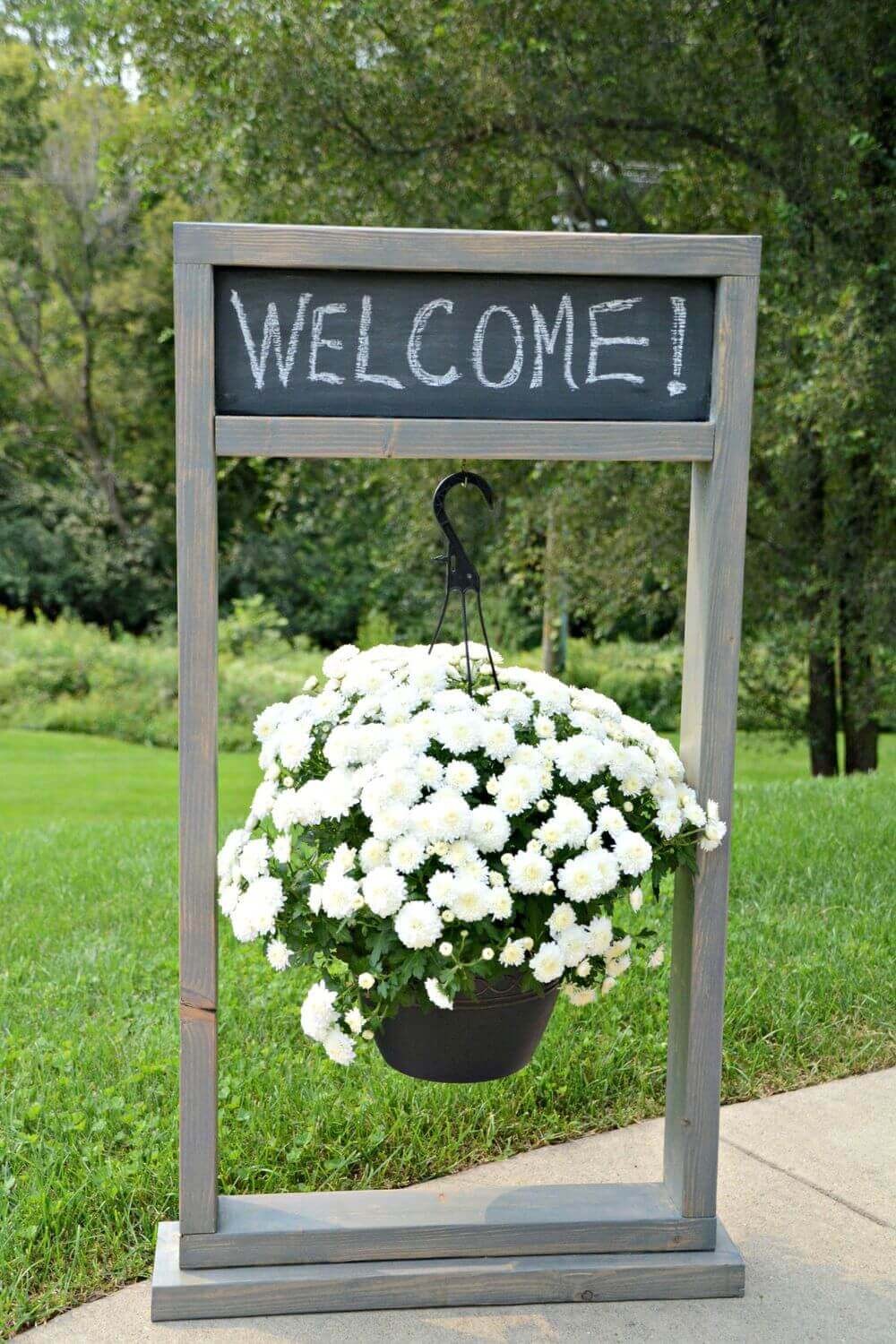

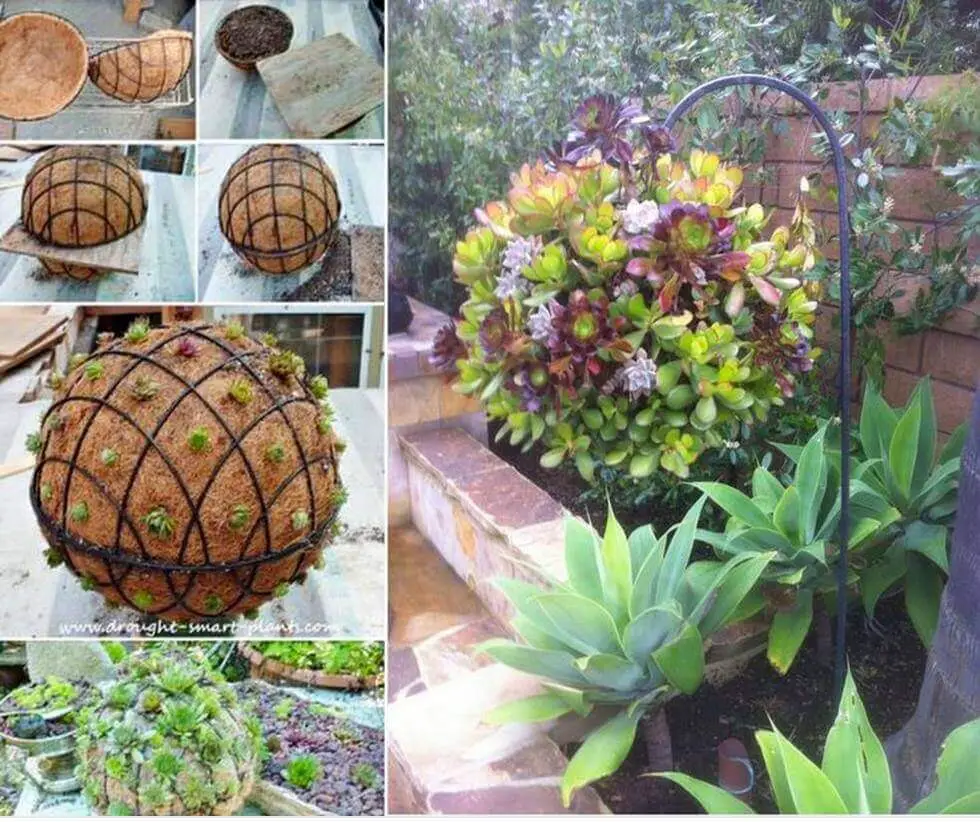
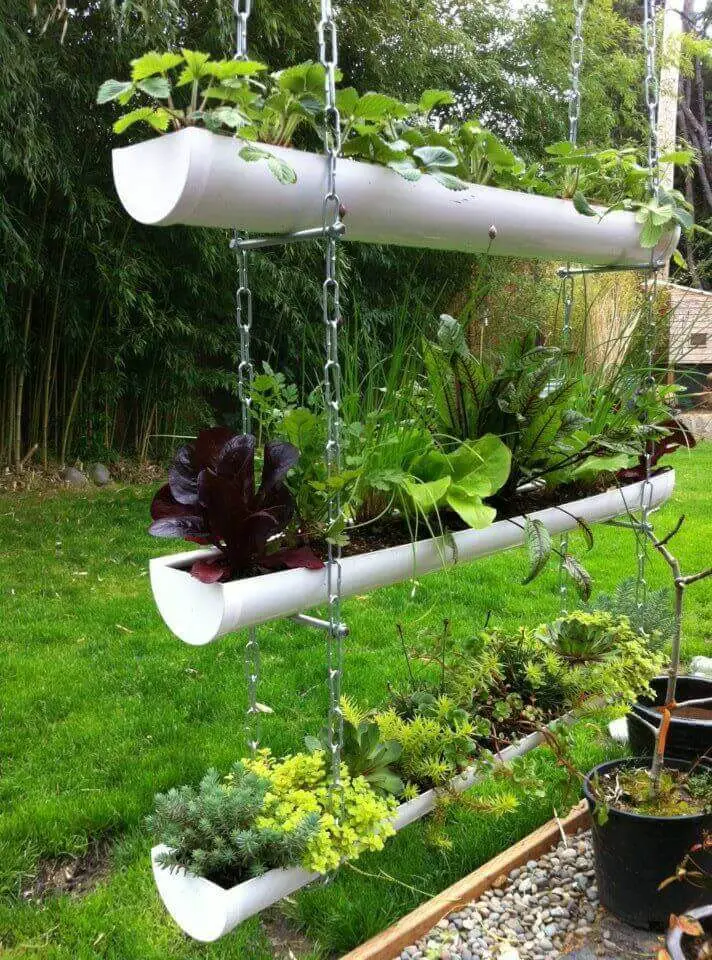
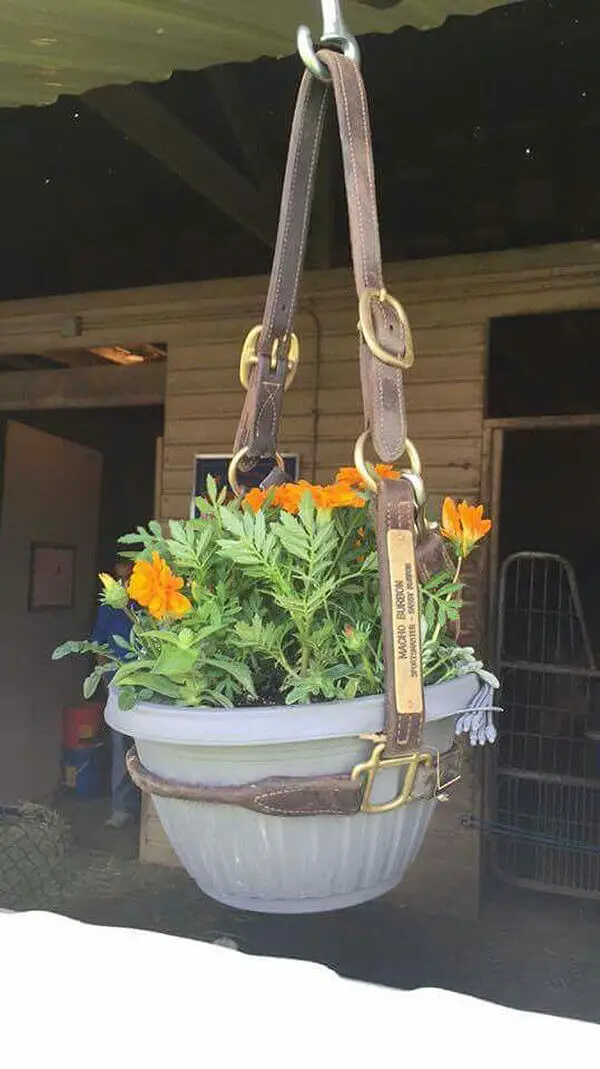










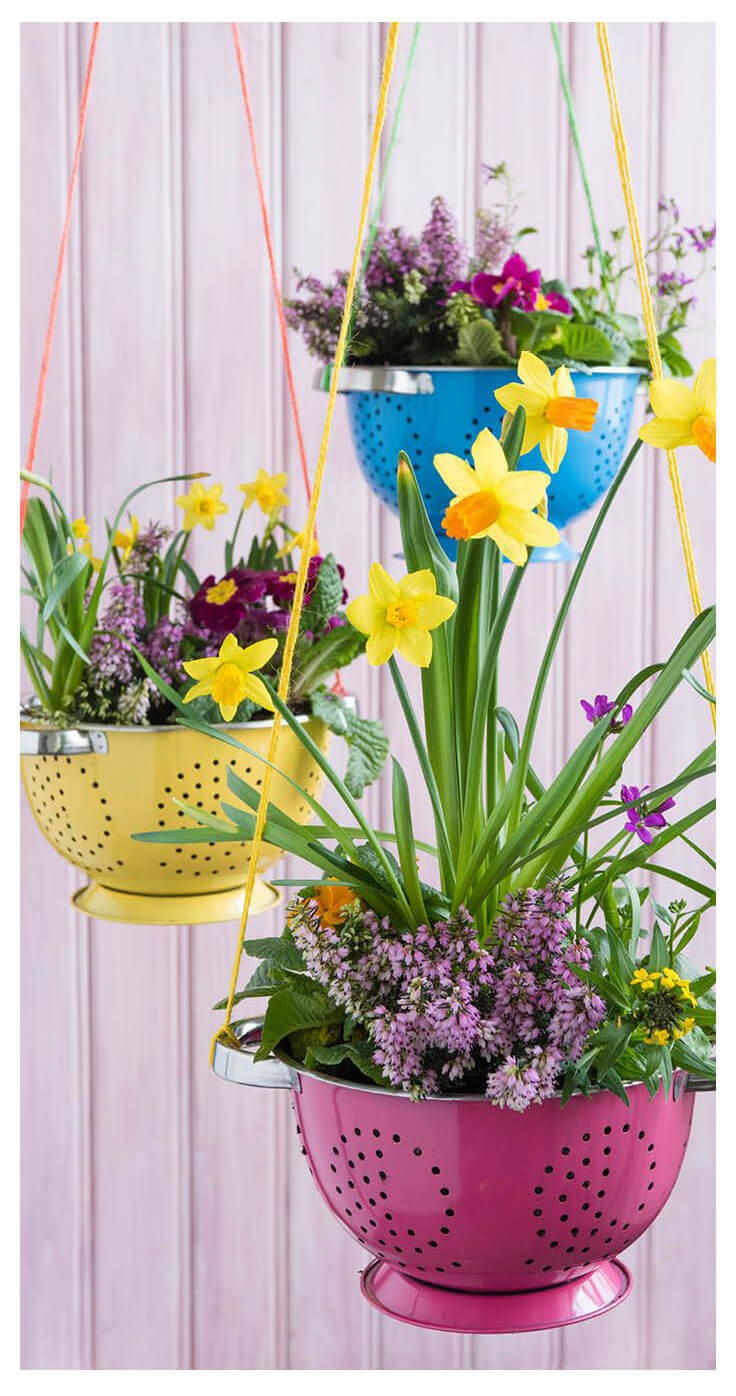









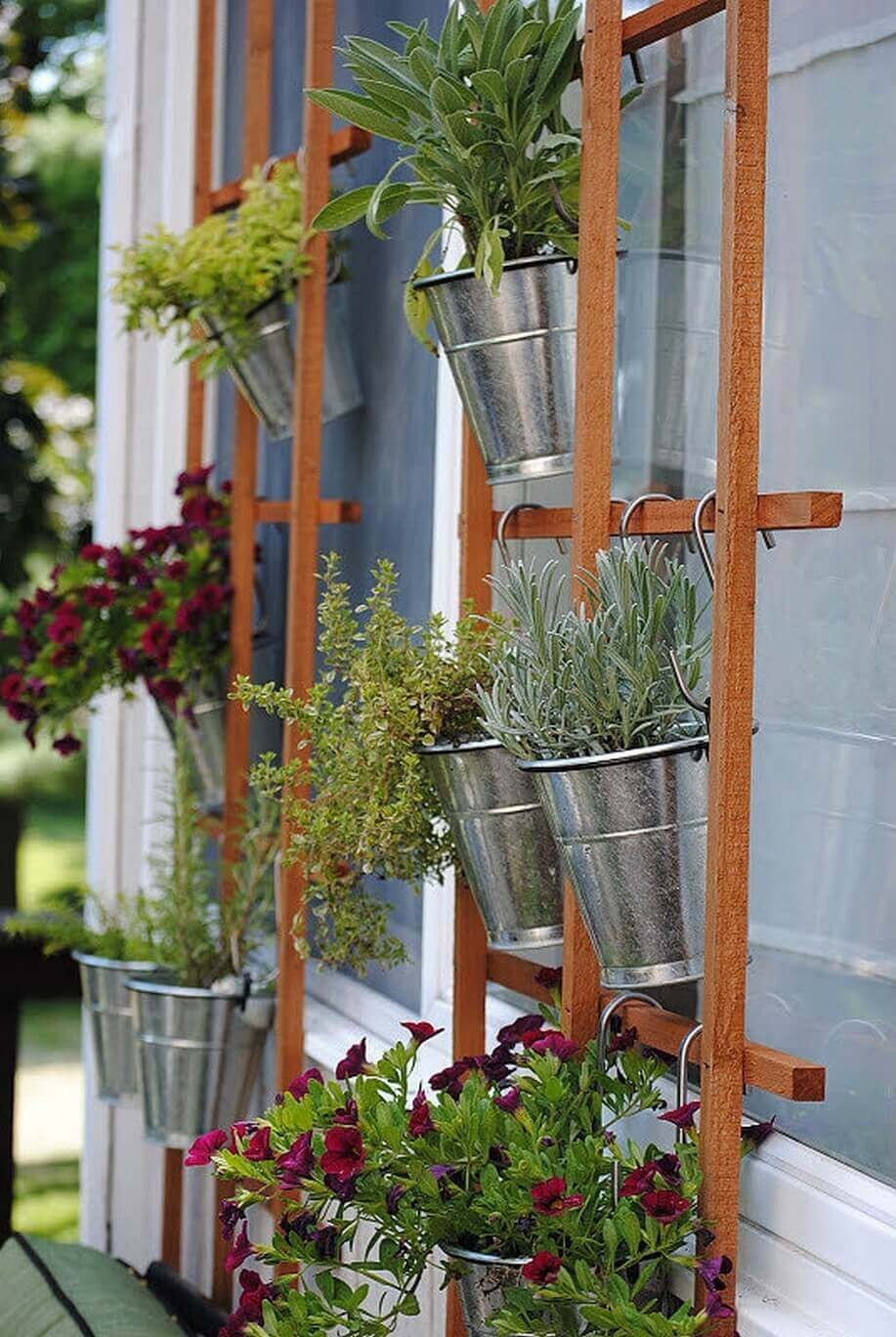





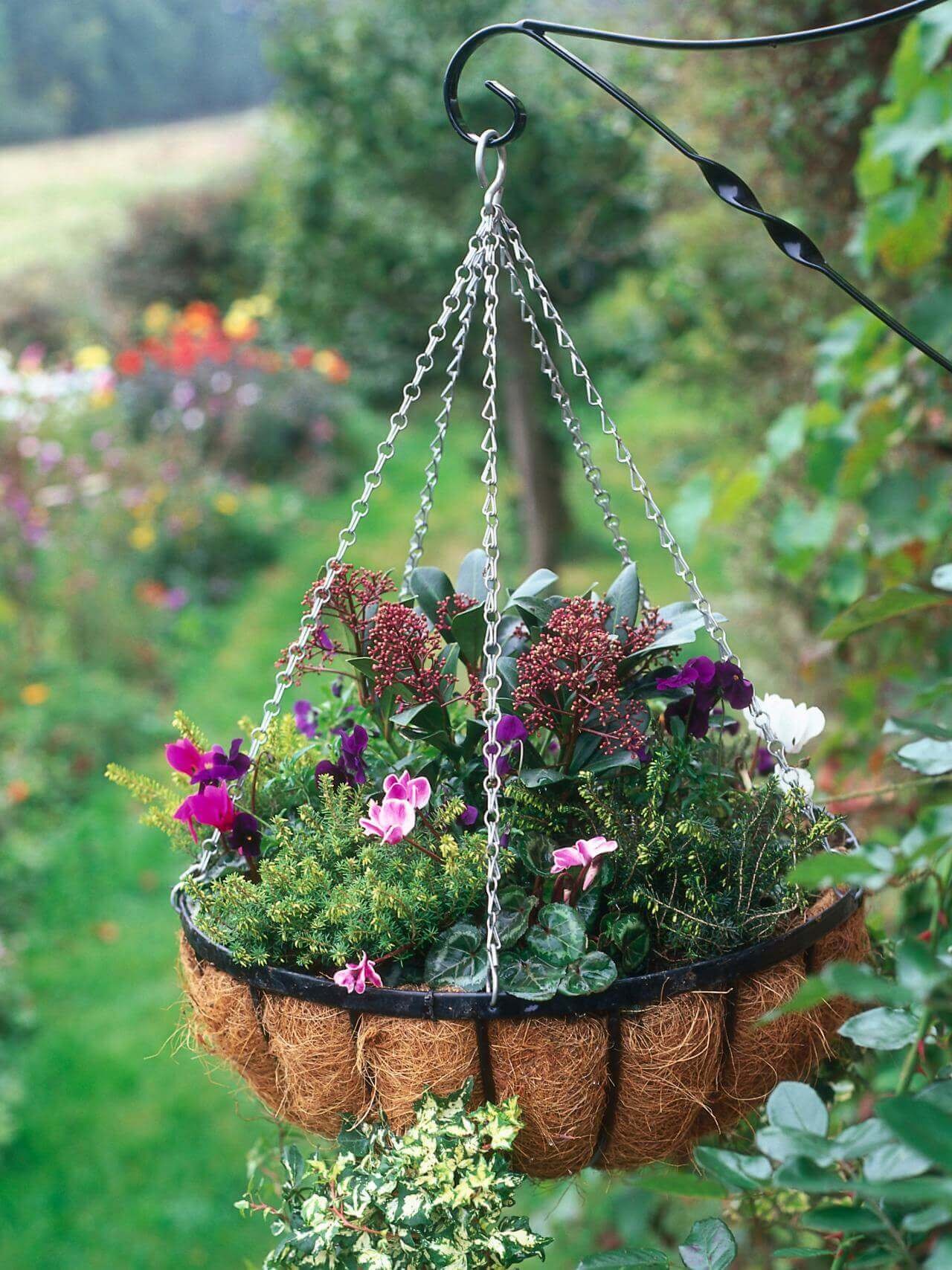







Hanging planters are a versatile and creative way to enhance outdoor events and celebrations, such as weddings, birthdays, seasonal holidays like Christmas or Halloween, and more. By choosing the right flowers, decorations, and colors, you can create a unique and memorable atmosphere that reflects the occasion’s spirit.
For instance, pastel-colored flowers in elegant macramé hangers can add a touch of romance to a wedding celebration, while vibrant and colorful flowers can create a festive ambiance for birthdays. To take it to the next level, consider incorporating seasonal elements, such as pumpkins or ornaments, to reflect the holiday’s theme. Whatever the occasion, hanging planters offer a beautiful way to bring your outdoor space to life.
Caring for Your Hanging Planters
To preserve the aesthetic appeal and overall well-being of your hanging planters, attention to detail beyond just regular watering is crucial. A thoughtful approach to care will enable your plants to flourish throughout the year. This includes adopting best practices for irrigation, nourishment, and seasonal maintenance, as well as strategies for addressing common problems that may arise.
Best Practices for Watering and Feeding Hanging Plants
When it comes to nurturing your plants, proper watering and feeding techniques are crucial for optimal health and growth. To ensure your hanging planters thrive, remember to monitor soil moisture regularly, taking care not to overwater by neglecting the importance of drainage holes. For a balanced approach, consider applying a water-soluble fertilizer every 4-6 weeks during the growing season, with reduced frequency during periods of dormancy.
Seasonal Care Tips to Ensure Year-Round Beauty
To ensure your plants thrive throughout the year, it’s essential to adapt your care routine according to the season. Here’s a breakdown of how you can tailor your approach:In the spring, as plants start to grow actively, they require more water and nutrients. This is the ideal time to resume regular feeding and increase watering. Your plants will appreciate the extra hydration and nutrition. Summer brings hot temperatures, which demand diligent watering to prevent stress from heat.
Make sure to water more frequently to keep your plants hydrated and healthy. As autumn approaches, it’s time to start preparing your plants for dormancy. This means reducing watering and feeding to help them transition into a state of reduced growth. Be mindful of this change, as some plants may require less care during this period. Finally, in the winter, many plants are dormant and require minimal water and no fertilizer.
However, it’s crucial to protect your plants from cold temperatures by keeping them away from drafts and maintaining a consistent temperature. By understanding these seasonal adjustments, you can provide the best possible care for your plants throughout the year.
Troubleshooting Common Issues with Hanging Planters
When it comes to caring for your hanging planters, even with the best intentions, unexpected issues can arise. Fortunately, most common problems have simple solutions. By recognizing the signs and taking proactive steps, you can address overwatering, pests, or lack of thriving in your plants.
Overwatering is often characterized by yellow leaves and a musty smell. To rectify this, ensure that your planters have proper drainage and allow the soil to dry out slightly between waterings.
This will help prevent root rot and other complications.
Pests like aphids and spider mites can also be a concern. To manage these unwanted visitors without harming your plants, consider using neem oil or insecticidal soap. These natural pesticides are effective in controlling infestations without posing a threat to the health of your greenery.
If you’re concerned that your plants aren’t thriving as they should, take a step back and evaluate whether they’re receiving the right amount of light, water, and nutrients. Sometimes, making adjustments to their environment or care routine can make all the difference. This might involve relocating a planter to a spot with better lighting or tweaking your watering schedule.
By staying attentive and making necessary adjustments, you can keep your hanging planters looking their best throughout the year. With regular attention and a proactive approach, you’ll be able to maintain the beauty and enjoyment that these plants bring to your outdoor space season after season.
Environmental Considerations and Sustainability
By embracing sustainable practices in your gardening routine, specifically with regards to hanging planters, you’ll not only be doing a world of good for the planet, but also create a lush and thriving oasis that showcases the natural beauty and vitality of your outdoor space. To make this vision a reality, let’s explore some simple yet effective ways to bring eco-friendliness into your hanging garden setup.
Using Eco-Friendly Materials for DIY Planters
When it comes to creating DIY planters for your garden, choosing materials that are gentle on the environment is a crucial step towards sustainable gardening practices. Fortunately, there are many eco-friendly options available. For instance, recycled plastic can reduce waste by repurposing items like soda bottles and food containers into functional planters.
Meanwhile, biodegradable pots made from natural materials like peat, paper, or cow manure offer a decomposition-friendly alternative that eliminates the need for waste disposal. Lastly, reclaimed wood from pallets or old furniture pieces can be transformed into unique, rustic hanging planters that not only conserve trees but also add a touch of character to your garden.
Tips for Sustainable Gardening Practices in Hanging Planters
When it comes to sustainable gardening, it’s not just about the tools you use – it’s also about the practices you employ. Here are some ways to make your gardening habits more environmentally friendly:
Water Efficiency: One of the simplest and most effective ways to reduce waste is by using a watering can that targets water directly at your plants, minimizing runoff.
Collecting rainwater is another fantastic way to conserve – just be sure to use it within 24 hours to prevent bacterial growth. This approach not only saves you money but also reduces strain on local water supplies.
Organic Amendments: Ditch chemical fertilizers and opt for natural, organic options instead. Composting kitchen scraps can provide a rich, nutrient-dense fertilizer that will feed your plants without harming the environment.
By choosing to compost, you’ll not only reduce waste but also create a valuable resource for your garden.
Pest Control: When it comes to managing pests, there’s no need to reach for toxic chemicals. Introduce beneficial insects into your garden or use homemade remedies like soap spray to keep unwanted visitors under control. These methods might require a bit more effort upfront, but they’re far more effective and environmentally friendly in the long run.
Encouraging Biodiversity with Plant Choices
When designing your hanging planters, consider the significant impact that plant selection can have on supporting local wildlife and promoting biodiversity. One key approach is to opt for native plants, which are naturally adapted to the local climate and soil conditions. This reduces the need for excessive watering and provides essential sustenance and shelter for native organisms.
You should also prioritize pollinator-friendly plants, such as flowers that attract bees, butterflies, and other pollinators. By doing so, you’ll be supporting the local ecosystem and ensuring your plants receive the necessary pollination. Additionally, a diverse selection of plant types not only creates a visually appealing display but also supports a wider range of organisms, thereby fostering a more resilient and thriving community.
Conclusion
Hanging planters bring an unparalleled level of versatility and aesthetic appeal to any outdoor setting, effortlessly transforming even the most compact spaces into thriving vertical gardens. This flexible design allows for creative experimentation with varying heights, textures, and colors, resulting in a living mosaic that not only enhances your home’s ambiance but also fosters a deeper connection with nature.
From understated macramé designs bursting with vibrant blooms to thoughtfully curated collections of eco-friendly containers showcasing resilient succulents, the possibilities are virtually limitless. Embrace the freedom to explore innovative ideas and integrate hanging planters into your outdoor spaces by combining different plants, crafting unique DIY planter designs, and selecting novel locations for your verdant creations.
By doing so, you can craft a one-of-a-kind outdoor retreat that authentically reflects your personal style and passion for horticulture. Remember, every small step towards incorporating plants into your life not only enriches the beauty of your home but also contributes to a healthier planet. So, let your creativity flourish, and witness as your hanging garden evolves into an awe-inspiring display of life, color, and vitality.






